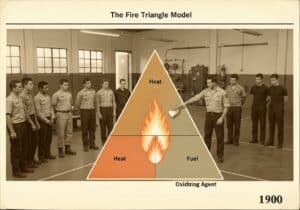This fire class, known as Class K in the US and Class F in Europe and Australia, involves combustible cooking media like vegetable oils, animal fats, and grease. These fires burn at very high temperatures, and applying water is extremely dangerous as it can cause a steam explosion (boilover) that spreads the burning grease. Specialized wet chemical extinguishers are the primary extinguishing method.
Class K / Class F Fires: Cooking Media
The creation of a separate class for cooking media fires was driven by changes in the food service industry. Modern, highly efficient deep-fat fryers heat cooking oils to sustained temperatures at or above their autoignition point. It was discovered that traditional dry chemical (Class B) extinguishers could extinguish the flame, but the oil would often re-ignite because it remained above its autoignition temperature. A new approach was needed.
The solution was the wet chemical agent, typically an aqueous solution of potassium acetate, potassium carbonate, or potassium citrate. When applied to burning cooking oil, this agent performs two functions. First, the water content has a cooling effect, lowering the temperature of the oil below its autoignition point. Second, the potassium salts react with the hot grease in a process called saponification. This chemical reaction creates a thick, soapy foam layer on the surface of the oil. This foam blanket effectively smothers the fire by cutting off the oxygen supply and prevents flammable vapors from escaping, thus preventing re-ignition.
The danger of using water on a grease fire is a key aspect of this class. Because oil is hotter than water’s boiling point, any water introduced instantly flashes to steam, expanding in volume by a factor of about 1,700. This rapid expansion ejects the burning oil from the pan, creating a large fireball and spreading the fire dramatically.
Taper
Perturbation
Usage
Précurseurs
- the proliferation of high-efficiency deep-fat fryers in commercial kitchens
- an observed high rate of re-ignition in cooking fires when using traditional class b extinguishers
- a scientific understanding of the saponification chemical reaction
- high incidence of severe fires and injuries in the restaurant industry
Applications
- automatic fire suppression systems installed in commercial kitchen ventilation hoods
- design of wet chemical portable fire extinguishers for restaurants and food processing plants
- fire safety education for culinary students and home cooks
- building code requirements for commercial cooking operations
- development of cooking oils with higher smoke points and reduced flammability
Brevets:
Idées d'innovations potentielles
!niveaux !!! Adhésion obligatoire
Vous devez être membre de l'association pour accéder à ce contenu.
DISPONIBLE POUR DE NOUVEAUX DÉFIS
Ingénieur mécanique, chef de projet, ingénierie des procédés ou R&D
Disponible pour un nouveau défi dans un court délai.
Contactez-moi sur LinkedIn
Intégration électronique métal-plastique, Conception à coût réduit, BPF, Ergonomie, Appareils et consommables de volume moyen à élevé, Production allégée, Secteurs réglementés, CE et FDA, CAO, Solidworks, Lean Sigma Black Belt, ISO 13485 médical
Nous recherchons un nouveau sponsor
Votre entreprise ou institution est dans le domaine de la technique, de la science ou de la recherche ?
> envoyez-nous un message <
Recevez tous les nouveaux articles
Gratuit, pas de spam, email non distribué ni revendu
ou vous pouvez obtenir votre adhésion complète - gratuitement - pour accéder à tout le contenu restreint >ici<
Inventions, innovations et principes techniques connexes













